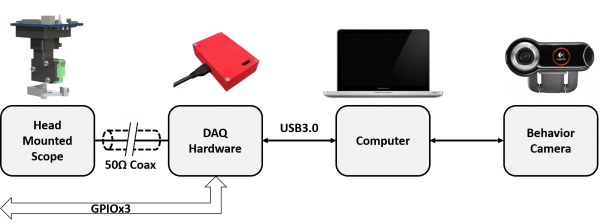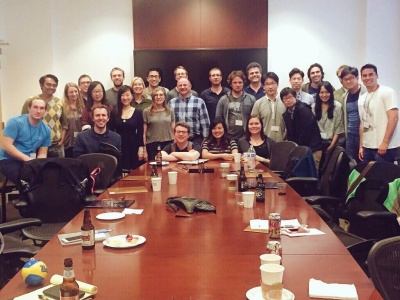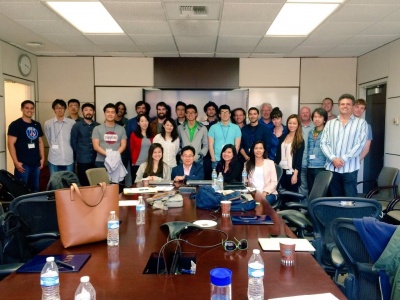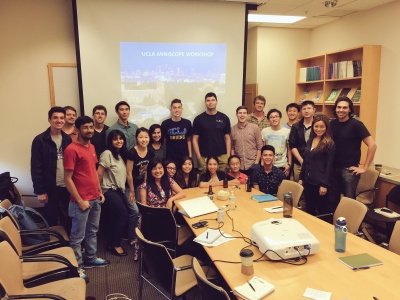Difference between revisions of "Main Page"
(→Current Status of Project) |
(→Workshop Resource) |
||
| Line 63: | Line 63: | ||
Image:UCLA_Worshop_June.JPG|UCLA Workshop, June 2016 | Image:UCLA_Worshop_June.JPG|UCLA Workshop, June 2016 | ||
Image:MCCS_Workshop_Nov2016.JPG|MCCS Miniscope Workshop, November 2016 | Image:MCCS_Workshop_Nov2016.JPG|MCCS Miniscope Workshop, November 2016 | ||
| + | Image:Workshop_April2017.JPG|April 2017 Workshop | ||
| + | Image:Germany_Workshop.JPG|Munich, Germany Workshop, August 2017 | ||
</gallery> | </gallery> | ||
Revision as of 14:26, 3 October 2017
Welcome to Miniscope.org Wiki! Follow the project on Twitter: @MiniscopeTeam.
The miniature fluorescence microscope described here is based on a design pioneered by Mark Schnitzer's Lab at Stanford and published in a paper in Nature Methods in 2011. It uses wide-field fluorescence imaging to record neural activity in awake, freely moving mice. The microscope introduced here (Miniscope) has a mass of 3 grams and uses a single, flexible coaxial cable (0.3mm to 1.5mm diameter) to carry power, control signals, and imaging data to custom open source Data Acquisition (DAQ) hardware and software. This wiki site provides a centralized location for sharing design files, source code, and other relevant information so that a community of users can share ideas and developments related to this important imaging technique. Our goal is to help disseminate this technology to the larger neuroscience community and build a foundation of users that will continue advancing this technology and contribute back to the project. While the Miniscope system described here is not an off-the-shelf commercial solution, we have focused on making it as easy as possible for the average neuroscience lab to build and modify, requiring minimal soldering and hands on assembly. For more information please visit the Project Overview page. The Miniscope project and Miniscope.org are still works in progress and will be routinely updated over the coming months and years. We hope you will contribute to this important process!
Contents
Current Status of Project
The Miniscope project is now in its third year of development at UCLA and has gone through two major revisions. Miniscopes were used to understand how the brain links memories across time, with the findings published in Nature, 2016. The work and files available on this site are the most up-to-date public version of our system and will be updated frequently with improvements and new system features. Again, we hope that you will contribute to this development process! This wiki is designed for this very purpose.
Initial access to the miniscope.org wiki was enabled mid January, 2016.
Important: Using this system we have successfully imaged Hippocampal CA1, Subiculum, Dorsal Striatum, Parietal Cortex, Prefrontal Cortex, and Visual Cortex using 0.5mm, 1mm, 1.8mm, and 2mm diameter GRIN lenses from either Grintech or GoFoton. (More information on GRIN lenses can be found here).
Links to information on miniscope subsystems
Discussion Board and FAQ
- Discussion Board (Our previous discussion board can be found here.. Please do not post here)
- FAQs
Guides and Tutorials
A key feature of this effort is to design miniscope systems that are easy to build and use. The guides below will walk you through component procurement, scope assembly, and software installation.
- Overview of System Components
- Part Procurement
- System Assembly
- Recommended Computer Specs
- Software and Firmware Setup
- Initial Testing of Assembled Miniscopes
- Imaging With Thin GRIN Lenses
- Surgery Protocol
- Animal Behavior Guide
Workshop Resource
We will be holding a pre-SfN workshop November 9th, 2017. For more information visit our MCCS/ICLM Workshop Page.
The Golshani, Silva, and Khakh labs will be hosting free, two-day long Miniscope workshops here at UCLA. We are currently planning at least 3 workshops for 2018. Please enter your information here to request a spot in upcoming workshops.
- Workshop April2017.JPG
April 2017 Workshop
- Germany Workshop.JPG
Munich, Germany Workshop, August 2017
If you cannot attend one of our workshops, presentations, data files, and workshop videos can be found on our Online Workshop page.
Miniscope Community Member Pages
Update Log
- 5/2/2017
- Updated 'Additional Open Source Resources' to include CNMF-E from the Paninski Lab and an open source miniature microscope from the Gardner Lab.
- 2/01/2017
- Added additional assembly and surgery tutorial videos.
- 11/29/2016
- Added a link on the front page to request a spot in upcoming Miniscope workshops.
- 10/28/2016
- Added version 3.2 of the DAQ PCB to the GitHub repository.
- 07/28/2016
- Added a new group PCB order signup sheet here.
- 07/21/2016
- Fixed bug that would crash the Miniscope DAQ software when using the 'Trigger Ext' option. This option is now fully functional and allows one to remotely trigger the Miniscope to record using a LVTTL or TTL high signal.
- 04/20/2016
- Added Initial Testing of Assembled Miniscopes which outlines the process of testing new Miniscope systems.
- 04/16/2016
- Added Imaging With Thin GRIN Lenses describing how to use Miniscopes to image with GRIN lenses 1mm diameter and thinner.
- 04/12/2016
- Added a new group PCB order signup sheet here.
- 04/13/2016
- Updated the GitHub repository to include the newer version of the CMOS Imaging Sensor PCB (v3.2).
- 03/25/2016
- Updated the Surgery and Baseplating Presentation link.
- Updated the Recommended Computer Specs page... Apparently a MacBook Pro running Windows 8 doesn't always agree with the Miniscope system.
- 03/18/2016
- Added the DAQ housing design files to our GitHub repository.
- 03/16/2016
- Added a Member Pages page for sharing miniscope.org member created pages.
- 02/24/2016
- Added a set of example Miniscope data to the Workshop Resources page.
- 02/17/2016
- Added a new way to connectorize the coaxial cable. This update includes a new PCB design on the GitHub repository as well as an assembly video on the System Assembly page.
- 02/10/2016
- Started adding videos to the Workshop Resource and System Assembly page
- 02/05/2016
- Updated the DAQ Software and Firmware to support FPS adjustment. The source code and compiled files can be found on our GitHub repository.
- 02/03/2016
- Updated Surgery Tools on Miniscope Master Parts List
- 01/28/2016
- Added PCB price quotes to reference when ordering PCB fabrication and assembly through Sierra Circuits. They can be found on the Part Procurement page.
- 01/27/2016
- IMPORTANT: Updated CMOS Imaging Sensor PCB Fabrication file to newest version
- 01/20/2016
- Updated Surgery Tools on Miniscope Master Parts List
- Added GRIN lens specifications on GRIN Lens Information page
- Updated the PCB Assembly documents on Github will a more detailed description of SMD LED orientation
- Slight modification to the Baseplate 3D model on Github
- 01/14/2016
- Comments added to segmentation functions
- Added through-hole components for DAQ PCB on Master Parts List
- Added additional soldering tools on Master Parts List
- 01/13/2016
- Added basic surgery outline
- Added a picture guide for scope and Baseplate assembly
- 01/12/2016
- Finalizing of Miniscope Master Parts List
- 01/10/2016
- Upload of current version of all files and documents to Github
- 01/09/2016
- Added guide to programming firmware to DAQ PCB






